Dynamic Evaluation and Internal Driving Factors of Water Resources Green Efficiency in China
Abstract
:1. Introduction
2. Literature Review
3. Materials and Methods
3.1. Hybrid Directional Distance Function with Mixed Disposability
3.2. Total Factor Productivity Index Model
3.3. Data Processing
3.3.1. Input Indicators
3.3.2. Expected Output Indicators
- Population growth refers to the ratio of the natural increase in the population (the number of births minus the number of deaths) for within a certain period of time (i.e., one year) to the average number (or the number of people in the current period).
- The proportion of the population aged 65 and over refers to the proportion of the population aged 65 and over in the sample survey during a certain period in each region.
- Engel’s coefficient refers to the proportion of total food expenditure in the total personal consumption expenditure.
- Urbanization rate refers to the proportion of permanent urban residents at the end of a year.
- Proportion of financial expenditures on education and science and technology refers to the education expenditure and science and technology expenditure in the general public budget expenditure in each region.
- Medical resources refer to the number of health technicians per 10,000 population.
3.3.3. Unexpected Output Indicators and Disposability Analysis
4. Result and Discussion
4.1. Dynamic Trend of Water Resources Green Efficiency
4.1.1. Time Variation Characteristics of Water Resources Green Efficiency Improvement
4.1.2. Spatial Differentiation Characteristics of Water Resources Green Efficiency Improvement
4.2. Decomposition of Driving Factors for Water Resources Green Efficiency
4.2.1. Time-Varying Characteristics of Water Resources Green Efficiency Decomposition
4.2.2. Spatial Differentiation Characteristics of Water Resources Green Efficiency Decomposition
5. Conclusions and Recommendations
5.1. Conclusions
5.2. Recommendations
Author Contributions
Funding
Acknowledgments
Conflicts of Interest
References
- Wada, Y.; De Graaf, I.E.M.; Van Beek, L.P.H. High-resolution modeling of human and climate impacts on global water resources. J. Adv. Model. Earth Syst. 2016, 8, 735–763. [Google Scholar] [CrossRef] [Green Version]
- The United Nations World Water Assessment Programme. The United Nations World Water Development Report 2014: Water and Energy; UNESCO: Paris, France, 2014. [Google Scholar]
- Jia, S.F.; Zhang, J. Institutional reform of water resources management in China. China Popul. Res. Environ. 2011, 21, 102–106. (In Chinese) [Google Scholar] [CrossRef]
- Nabi, G.; Ali, M.; Khan, S.; Kumar, S. The crisis of water shortage and pollution in Pakistan: Risk to public health, biodiversity, and ecosystem. Environ. Sci. Pollut. Res. 2019, 26, 10443–10445. [Google Scholar] [CrossRef] [PubMed] [Green Version]
- Thoradeniya, B.; Pinto, U.; Maheshwari, B. Perspectives on impacts of water quality on agriculture and community well-being—A key informant study from Sri Lanka. Environ. Sci. Pollut. Res. 2017, 26, 2047–2061. [Google Scholar] [CrossRef]
- Wenter, A.; Zanotelli, D.; Montagnani, L.; Tagliavini, M.; Andreotti, C. Effect of different timings and intensities of water stress on yield and berry composition of grapevine (cv. Sauvignon blanc) in a mountain environment. Sci. Hortic. 2018, 236, 137–145. [Google Scholar] [CrossRef]
- Legesse, G.; Cordeiro, M.R.C.; Ominski, K.H.; Beauchemin, K.A.; Kröbel, R.; McGeough, E.; Pogue, S.; McAllister, T.A. Water use intensity of Canadian beef production in 1981 as compared to 2011. Sci. Total. Environ. 2018, 619, 1030–1039. [Google Scholar] [CrossRef]
- Yawen, Z.X.L. Changes and mechanism of internal water use of products in Tianjin. Res. Sci. 2016, 38, 52–63. [Google Scholar] [CrossRef]
- Kopp, R.J. The Measurement of Productive Efficiency: A Reconsideration. Q. J. Econ. 1981, 96, 477. [Google Scholar] [CrossRef]
- Lei, Y.T.; Huang, L.P.; Zhang, H. Research on the dynamic evolution and the driving factors of industrial water consumption efficiency in China. Res. Environ. Yangtze Basin. 2017, 26, 159–170. (In Chinese) [Google Scholar] [CrossRef]
- Mellah, T.; Ben Amor, T. Performance of the Tunisian Water Utility: An input-distance function approach. Util. Policy 2016, 38, 18–32. [Google Scholar] [CrossRef]
- Guerrini, A.; Romano, G.; Leardini, C. Economies of scale and density in the Italian water industry: A stochastic frontier approach. Util. Policy 2018, 52, 103–111. [Google Scholar] [CrossRef]
- Gadanakis, Y.; Bennett, R.; Park, J.; Areal, F.J. Improving productivity and water use efficiency: A case study of farms in England. Agric. Water Manag. 2015, 160, 22–32. [Google Scholar] [CrossRef] [Green Version]
- Morales, M.; Heaney, J. Benchmarking Nonresidential Water Use Efficiency Using Parcel-Level Data. J. Water Resour. Plan. Manag. 2016, 142, 04015064. [Google Scholar] [CrossRef] [Green Version]
- Tone, K. A slacks-based measure of efficiency in data envelopment analysis. Eur. J. Oper. Res. 2001, 130, 498–509. [Google Scholar] [CrossRef] [Green Version]
- Jin, W.; Liu, S.S.; Zhang, K.; Kong, W. Influence of agricultural production efficiency on agricultural water consumption. J. Nat. Res. 2018, 33, 1326–1339. (In Chinese) [Google Scholar] [CrossRef]
- Färe, R.; Njinkeu, D. Computing returns to scale under alternative models. Econ. Lett. 1989, 30, 55–59. [Google Scholar] [CrossRef]
- Yang, W.; Li, L. Analysis of Total Factor Efficiency of Water Resource and Energy in China: A Study Based on DEA-SBM Model. Sustainability 2017, 9, 1316. [Google Scholar] [CrossRef] [Green Version]
- Rolfe, J.; Windle, J.; McCosker, K.; Northey, A. Assessing cost-effectiveness when environmental benefits are bundled: Agricultural water management in Great Barrier Reef catchments. Aust. J. Agric. Resour. Econ. 2018, 62, 373–393. [Google Scholar] [CrossRef] [Green Version]
- Lorenzo-Toja, Y.; Vázquez-Rowe, I.; Marín-Navarro, D.; Crujeiras, R.M.; Moreira, M.T.; Feijoo, G. Dynamic environmental efficiency assessment for wastewater treatment plants. Int. J. Life Cycle Assess. 2017, 23, 357–367. [Google Scholar] [CrossRef]
- Shi, T.; Zhang, X.; Du, H.; Shi, H. Urban water resource utilization efficiency in China. Chin. Geogr. Sci. 2015, 25, 684–697. [Google Scholar] [CrossRef] [Green Version]
- Maziotis, A.; Molinos-Senante, M.; Sala-Garrido, R. Assesing the Impact of Quality of Service on the Productivity of Water Industry: A Malmquist-Luenberger Approach for England and Wales. Water Resour. Manag. 2016, 31, 2407–2427. [Google Scholar] [CrossRef]
- Song, M.; Wang, R.; Zeng, X. Water resources utilization efficiency and influence factors under environmental restrictions. J. Clean. Prod. 2018, 184, 611–621. [Google Scholar] [CrossRef]
- Huang, R.; Li, Y. Undesirable input–output two-phase DEA model in an environmental performance audit. Math. Comput. Model. 2013, 58, 971–979. [Google Scholar] [CrossRef]
- Worthington, A.C. A review of frontier approaches to efficiency and productivity measurement in urban water utilities. Urban Water J. 2013, 11, 55–73. [Google Scholar] [CrossRef]
- Wang, S.; Zhou, L.; Wang, H.; Li, X. Water Use Efficiency and Its Influencing Factors in China: Based on the Data Envelopment Analysis (DEA)—Tobit Model. Water 2018, 10, 832. [Google Scholar] [CrossRef] [Green Version]
- Zhao, L.; Sun, C.; Liu, F. Interprovincial two-stage water resource utilization efficiency under environmental constraint and spatial spillover effects in China. J. Clean. Prod. 2017, 164, 715–725. [Google Scholar] [CrossRef]
- Li, J.; Ma, X.-C. Econometric analysis of industrial water use efficiency in China. Environ. Dev. Sustain. 2014, 17, 1209–1226. [Google Scholar] [CrossRef]
- Wang, Y.; Bian, Y.; Xu, H. Water use efficiency and related pollutants’ abatement costs of regional industrial systems in China: A slacks-based measure approach. J. Clean. Prod. 2015, 101, 301–310. [Google Scholar] [CrossRef]
- Che, L.; Bai, Y.P.; Zhou, L.; Wang, F.; Ji, X.M.; Qiao, F.W. Spatial pattern and spillover effects of green development efficiency in China. Sci. Geogr. Sin. 2018, 38, 1788–1798. (In Chinese) [Google Scholar] [CrossRef]
- Jin, W.; Zhang, H.-Q.; Liu, S.-S.; Zhang, H.-B. Technological innovation, environmental regulation, and green total factor efficiency of industrial water resources. J. Clean. Prod. 2019, 211, 61–69. [Google Scholar] [CrossRef]
- Fu, J.; Xiao, G.; Guo, L.; Wu, C. Measuring the Dynamic Efficiency of Regional Industrial Green Transformation in China. Sustainability 2018, 10, 628. [Google Scholar] [CrossRef] [Green Version]
- Geng, Y.; Wang, M.; Sarkis, J.; Xue, B.; Zhang, L.; Fujita, T.; Yu, X.; Ren, W.; Zhang, L.; Dong, H. Spatial-temporal patterns and driving factors for industrial wastewater emission in China. J. Clean. Prod. 2014, 76, 116–124. [Google Scholar] [CrossRef]
- Shang, Y.; Lu, S.; Li, X.; Sun, G.; Shang, L.; Shi, H.; Lei, X.; Ye, Y.; Sang, X.; Wang, H. Drivers of industrial water use during 2003–2012 in Tianjin, China: A structural decomposition analysis. J. Clean. Prod. 2017, 140, 1136–1147. [Google Scholar] [CrossRef]
- Sun, C.; Zhao, L.; Zou, W.; Zheng, D.-F. Water resource utilization efficiency and spatial spillover effects in China. J. Geogr. Sci. 2014, 24, 771–788. [Google Scholar] [CrossRef] [Green Version]
- Ma, H.; Shi, C.; Chou, N.-T. China’s Water Utilization Efficiency: An Analysis with Environmental Considerations. Sustainablity 2016, 8, 516. [Google Scholar] [CrossRef] [Green Version]
- Li, Y.L.; Wu, C. Random DEA model considering the weak disposability of undesirable outputs. J. Manag. Sci. China 2014, 17, 17–28. (In Chinese) [Google Scholar] [CrossRef]
- Xue, S.; Yang, T.; Zhang, K.; Feng, J. Spatial effect and influencing factors of agricultural water enivronmental efficiency in China. Appl. Ecol. Environ. Res. 2018, 16, 4491–4504. [Google Scholar] [CrossRef]
- Charnes, A.; Cooper, W.; Rhodes, E. Measuring the efficiency of decision making units. Eur. J. Oper. Res. 1978, 2, 429–444. [Google Scholar] [CrossRef]
- Zhou, X.; Luo, R.; Yao, L.; Cao, S.; Wang, S.; Lev, B. Assessing integrated water use and wastewater treatment systems in China: A mixed network structure two-stage SBM DEA model. J. Clean. Prod. 2018, 185, 533–546. [Google Scholar] [CrossRef]
- Färe, R.; Grosskopf, S. Directional distance functions and slacks-based measures of efficiency: Some clarifications. Eur. J. Oper. Res. 2010, 206, 702. [Google Scholar] [CrossRef]
- Tone, K. A Hybrid Measure of Efficiency in DEA; GRIPS Policy Information Center Research Report; National Graduate Institute for Policy Studies: Tokyo, Japan, 2004. [Google Scholar]
- Cheng, G. Data Development Analysis: Methods and MaxDEA Software; Intellectual Property Publishing House: Beijing, China, 2017. [Google Scholar]
- Chung, Y.; Färe, R.; Grosskopf, S. Productivity and Undesirable Outputs: A Directional Distance Function Approach. J. Environ. Manag. 1997, 51, 229–240. [Google Scholar] [CrossRef] [Green Version]
- Oh, D.-H. A global Malmquist-Luenberger productivity index. J. Prod. Anal. 2010, 34, 183–197. [Google Scholar] [CrossRef]
- Zofío, J.L. Malmquist productivity index decompositions: A unifying framework. Appl. Econ. 2007, 39, 2371–2387. [Google Scholar] [CrossRef] [Green Version]
- Shan, H.J. Reestimating the capital stock of China: 1952–2006. J. Quant. Tech. Econ. 2008, 10, 17–31. (In Chinese) [Google Scholar] [CrossRef]
- Medrano, H.; Tomás, M.; Martorell, S.; Escalona, J.-M.; Pou, A.; Fuentes, S.; Flexas, J.; Bota, J. Improving water use efficiency of vineyards in semi-arid regions. A review. Agron. Sustain. Dev. 2014, 35, 499–517. [Google Scholar] [CrossRef] [Green Version]
- Urpelainen, J. Export orientation and domestic electricity generation: Effects on energy efficiency innovation in select sectors. Energy Policy 2011, 39, 5638–5646. [Google Scholar] [CrossRef]
- Stern, D.I. Modeling international trends in energy efficiency. Energy Econ. 2012, 34, 2200–2208. [Google Scholar] [CrossRef]
- Chhipi-Shrestha, G.; Hewage, K.; Sadiq, R. Water–Energy–Carbon Nexus Modeling for Urban Water Systems: System Dynamics Approach. J. Water Resour. Plan. Manag. 2017, 143, 04017016. [Google Scholar] [CrossRef]
- Yousefi, M.; Khoramivafa, M.; Damghani, A.M. Water footprint and carbon footprint of the energy consumption in sunflower agroecosystems. Environ. Sci. Pollut. Res. 2017, 24, 19827–19834. [Google Scholar] [CrossRef]
- Xu, J. Coupling mechanism of regional carbon-water symbiosis system and water resources regulation and control under low carbon perspective. Appl. Ecol. Environ. Res. 2017, 15, 457–465. [Google Scholar] [CrossRef]
- Sun, C.Z.; Jiang, K.; Zhao, L.S. Measurement of green efficiency of water utilization and its spatial pattern in China. J. Nat. Res. 2017, 32, 1999–2011. (In Chinese) [Google Scholar] [CrossRef]
- Lai, S.Y.; Du, P.F.; Chen, J.N. Evaluation of non-point source pollution based on unit analysis. J. Tsinghua Univ. 2004, 44, 1184–1187. [Google Scholar] [CrossRef]
- Chen, S.; Shiyi, C. Engine or drag: Can high energy consumption and CO2 emission drive the sustainable development of Chinese industry? Front. Econ. China 2009, 4, 548–571. [Google Scholar] [CrossRef]
- Xiong, Y.; Peng, S.; Luo, Y.; Xu, J.; Yang, S. A paddy eco-ditch and wetland system to reduce non-point source pollution from rice-based production system while maintaining water use efficiency. Environ. Sci. Pollut. Res. 2014, 22, 4406–4417. [Google Scholar] [CrossRef]
- Sun, C.Z.; Ma, Q.F.; Zhao, L.S. Green efficiency changes for water resources in china based on SBM-Malmquist model. Res. Sci. 2018, 40, 993–1005. (In Chinese) [Google Scholar] [CrossRef]
- Liu, S.S.; Han, F.M.; Cai, A.N.; Zhang, K.; Jin, W. Influence of agricultural water use efficiency on agricultural water consumption in consideration of regional differences. Res. Environ. Yangtze Basin 2017, 26, 2099–2110. (In Chinese) [Google Scholar] [CrossRef]
- Henderson, A.R. The bootstrap: A technique for data-driven statistics. Using computer-intensive analyses to explore experimental data. Clin. Chim. Acta 2005, 359, 1–26. [Google Scholar] [CrossRef]
- Hu, B.; Wang, F.; Li, J.Y.; Yu, L.Y.; Zhang, S.H. Efficiency evaluation on urban eco-civilization construction via SBM-Undesirable Model-Taking Tianjin as an example. J. Arid Land Res. Environ. 2015, 29, 13–18. (In Chinese) [Google Scholar] [CrossRef]

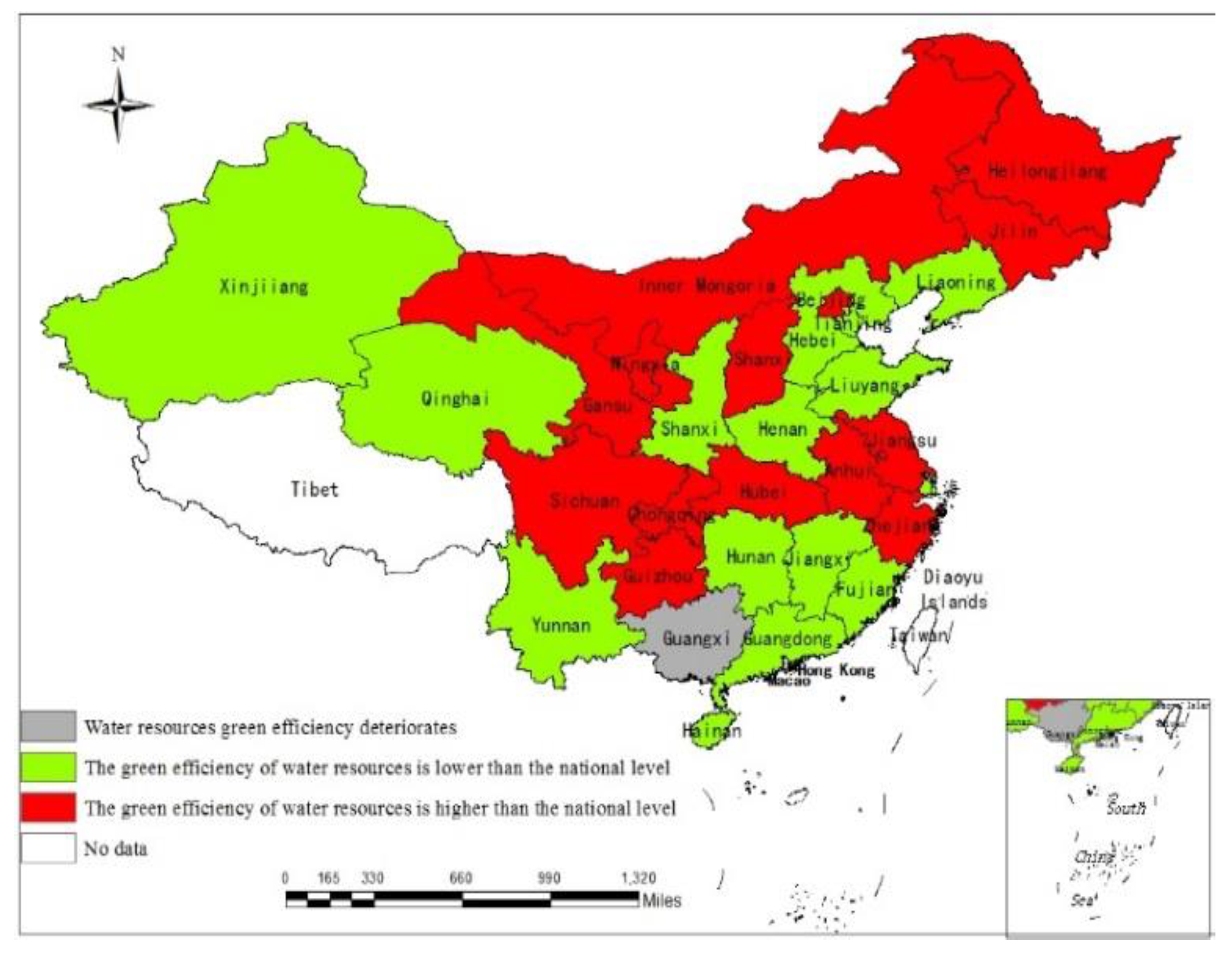
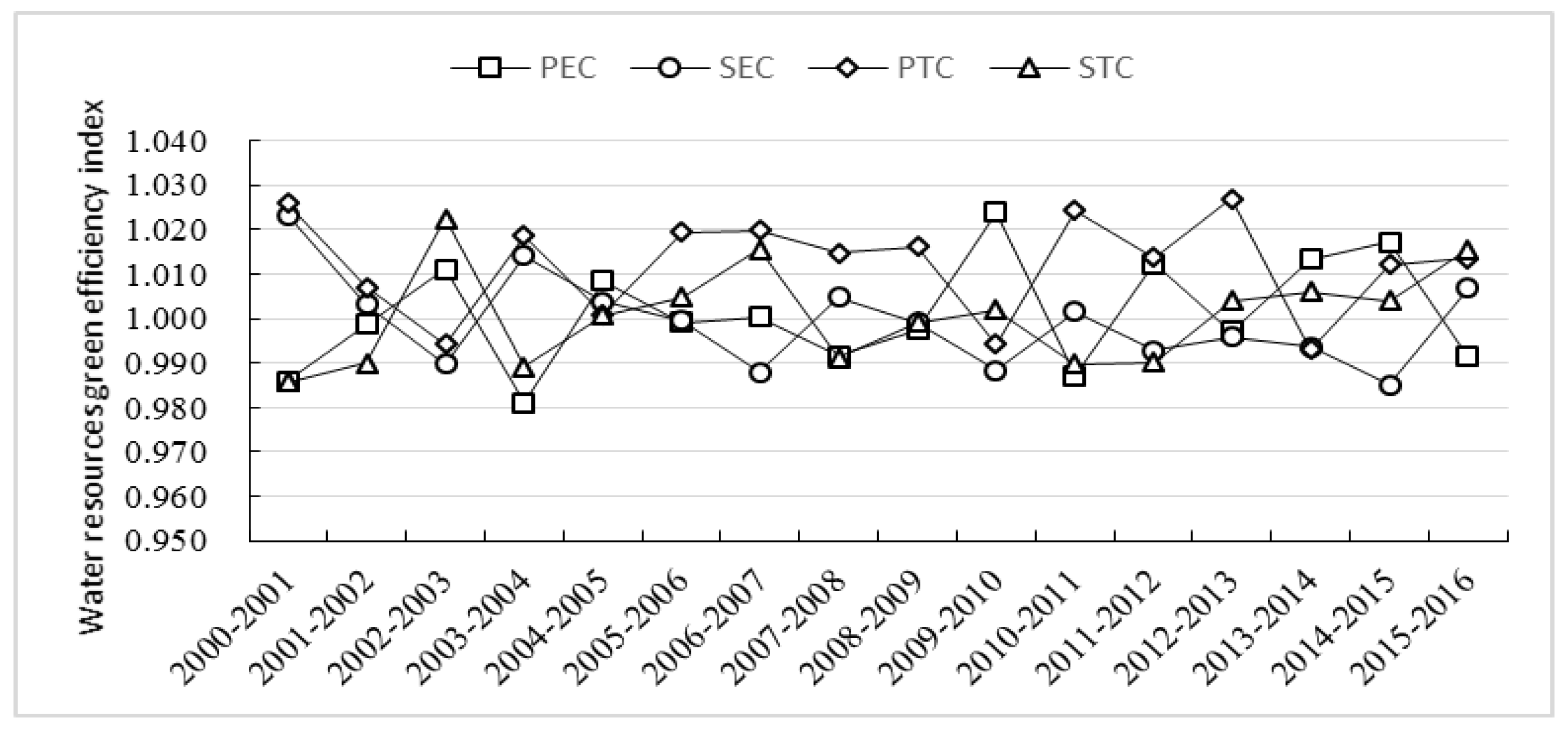
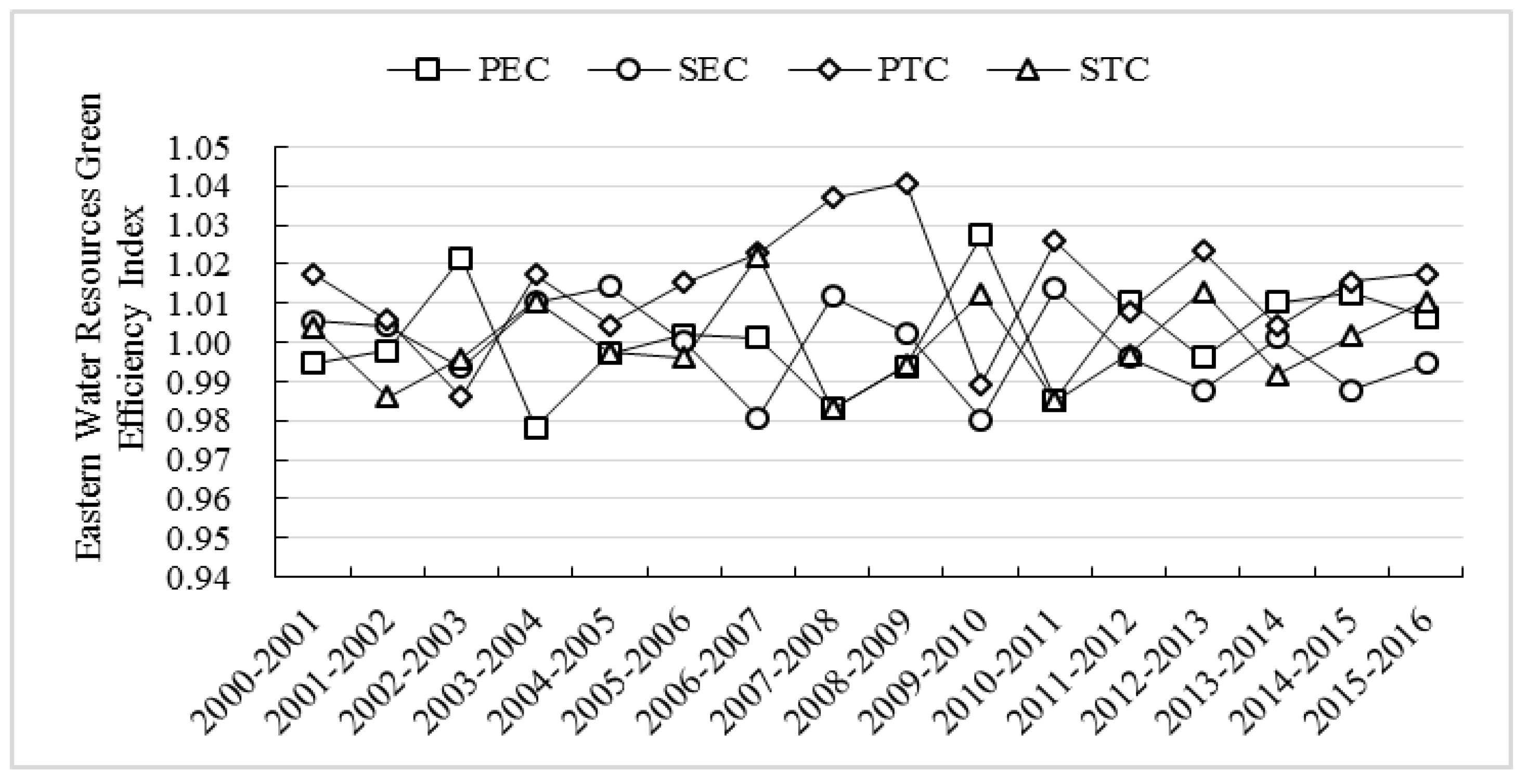

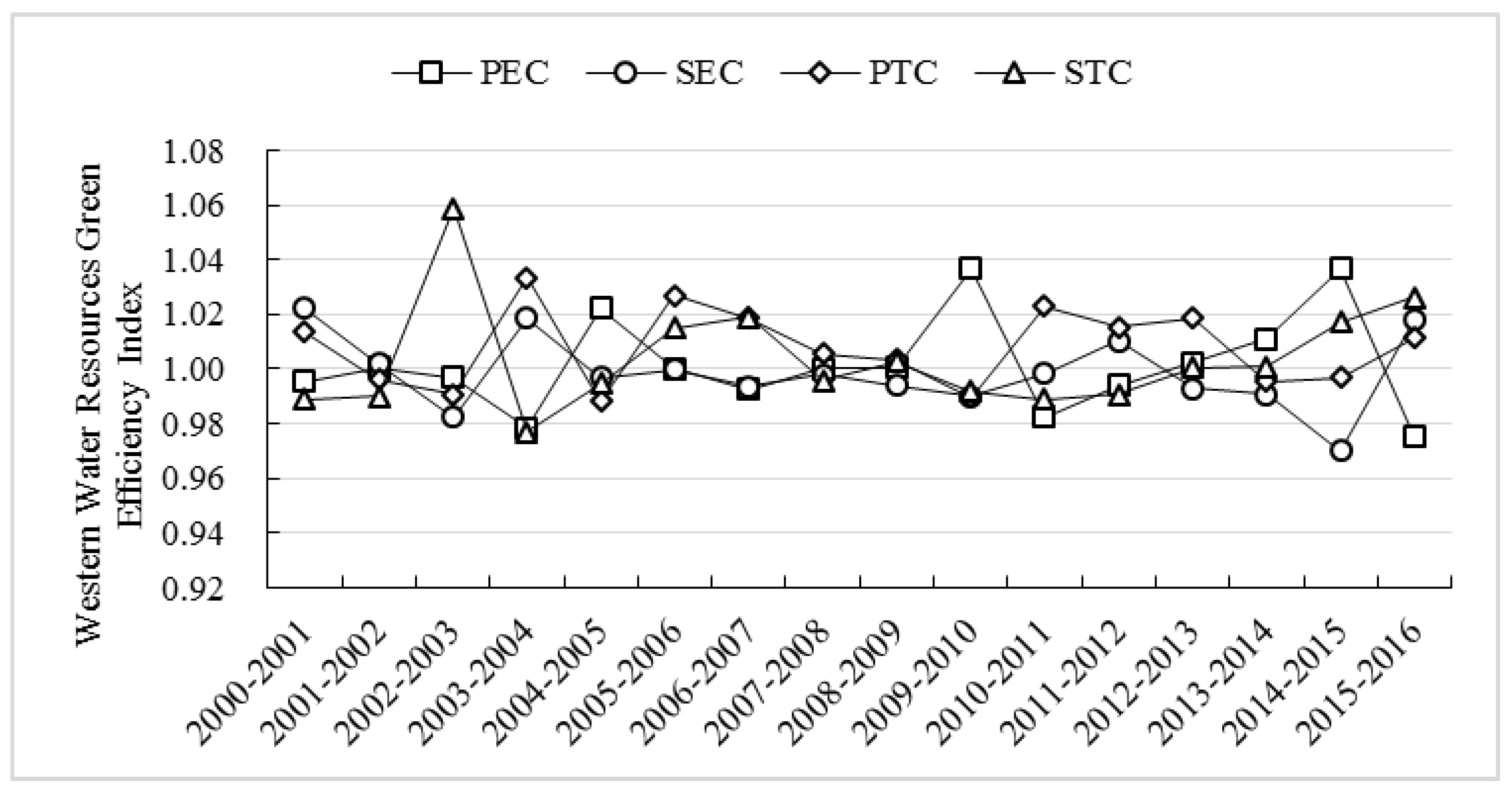
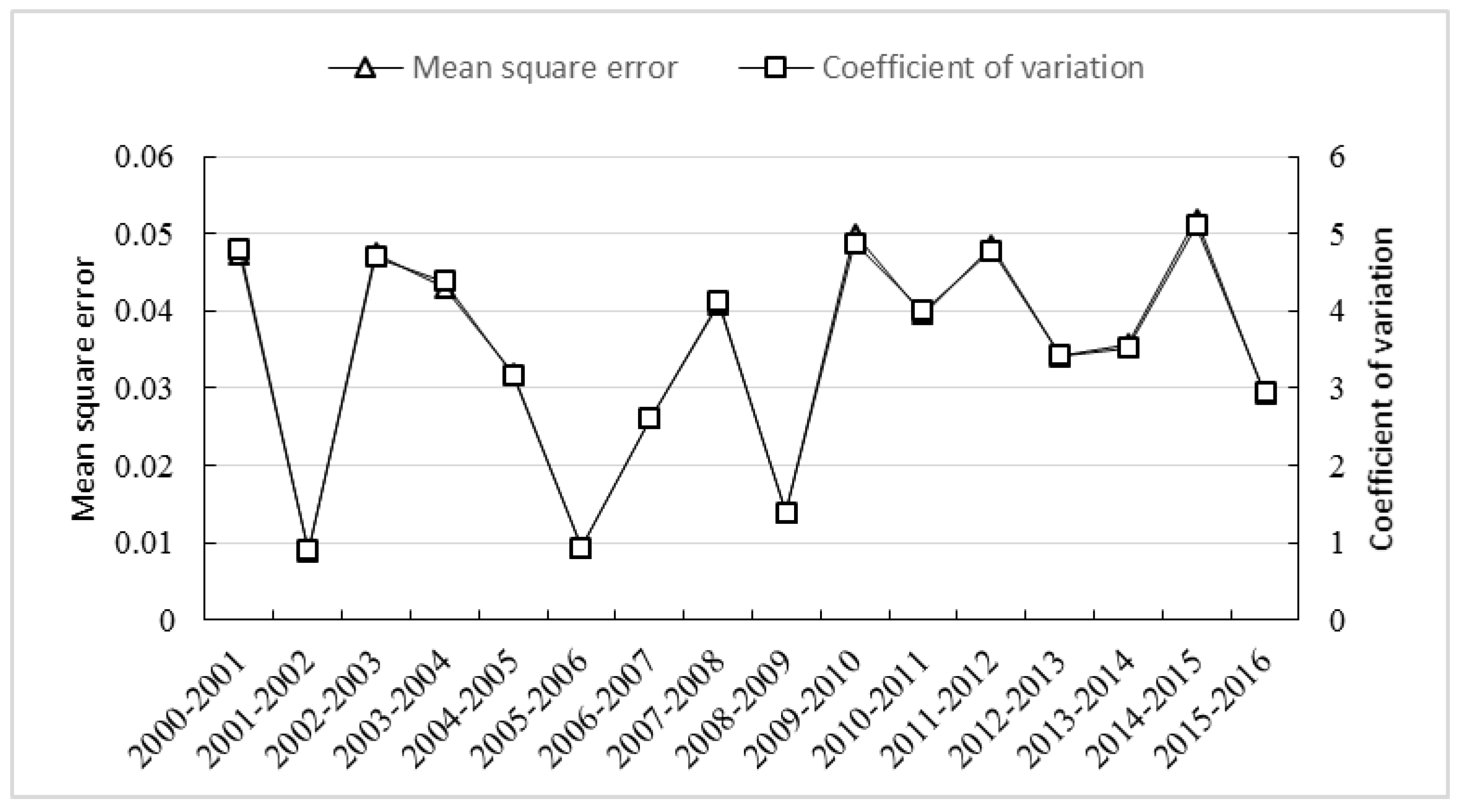
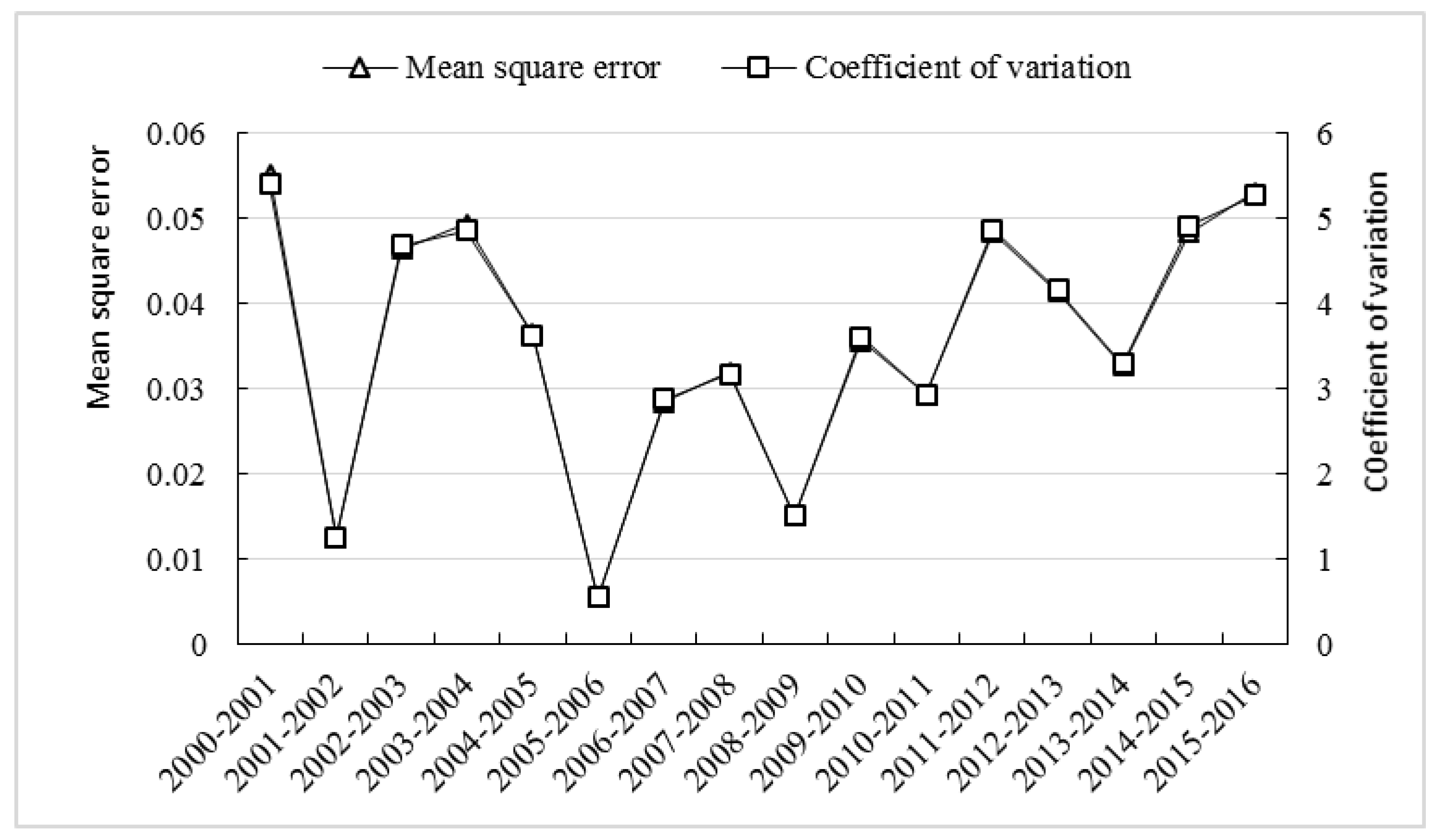


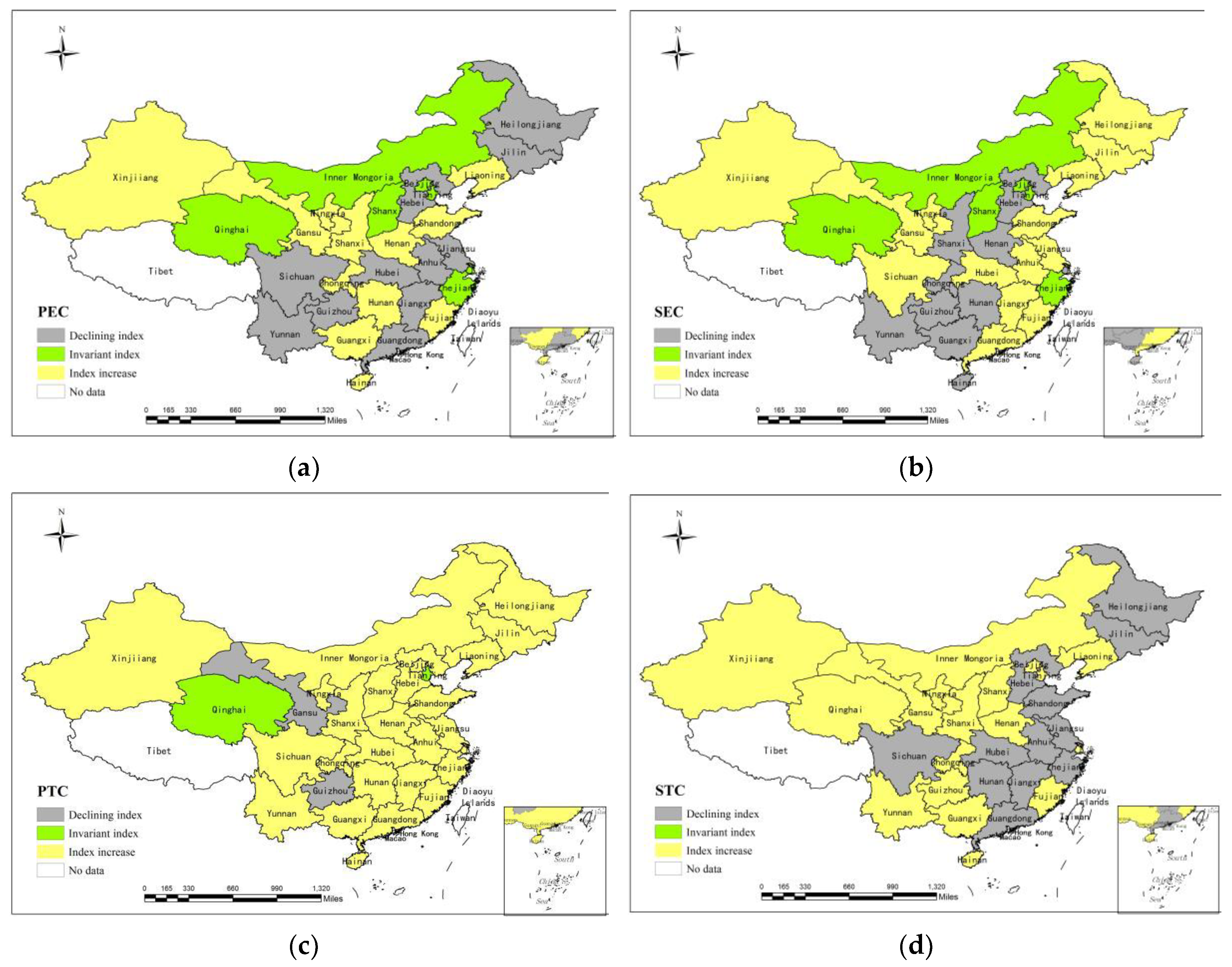
| Destination Layer | Names of Index | Meaning of Evaluation Index | Index Attribute |
|---|---|---|---|
| social development index (SDI) | population growth rate | population growth | high-quality indicator |
| population age structure | proportion of the population aged 65 and over | low-quality indicator | |
| living status of inhabitants | Engel’s coefficient | low-quality indicator | |
| urban development level | urbanization rate | high-quality indicator | |
| technological and educational financial input | proportion of financial expenditures on education and science and technology | high-quality indicator | |
| medical resources | health technicians per 10,000 population | high-quality indicator |
| Province | 2000–2001 | 2003–2004 | 2006–2007 | 2009–2010 | 2013–2014 | 2015–2016 | Mean |
|---|---|---|---|---|---|---|---|
| Beijing | 1.033 | 1.007 | 1.042 | 0.935 | 0.990 | 1.013 | 1.024 |
| Tianjin | 1.000 | 1.162 | 1.000 | 1.000 | 1.000 | 1.000 | 1.001 |
| Hebei | 0.995 | 0.993 | 1.021 | 1.012 | 1.008 | 1.046 | 1.011 |
| Shanxi | 1.040 | 0.830 | 1.000 | 0.975 | 1.000 | 1.000 | 1.028 |
| Inner Mongolia | 1.038 | 1.022 | 1.045 | 0.932 | 0.994 | 1.069 | 1.022 |
| Liaoning | 1.000 | 1.000 | 1.000 | 1.008 | 1.000 | 1.000 | 1.000 |
| Jilin | 1.027 | 1.005 | 1.004 | 0.997 | 0.998 | 1.151 | 1.015 |
| Heilongjiang | 1.016 | 1.025 | 1.055 | 1.019 | 1.012 | 1.052 | 1.017 |
| Shanghai | 1.000 | 1.200 | 1.000 | 1.000 | 1.000 | 1.000 | 1.004 |
| Jiangsu | 1.040 | 0.988 | 1.026 | 1.004 | 1.031 | 1.063 | 1.021 |
| Zhejiang | 1.026 | 0.991 | 1.048 | 1.046 | 1.017 | 1.000 | 1.015 |
| Anhui | 0.996 | 1.024 | 1.027 | 1.056 | 1.000 | 1.000 | 1.020 |
| Fujian | 1.000 | 1.000 | 1.000 | 1.003 | 0.998 | 1.003 | 1.000 |
| Jiangxi | 1.013 | 0.987 | 1.036 | 0.994 | 1.010 | 1.022 | 1.010 |
| Shandong | 0.999 | 1.005 | 1.006 | 1.013 | 1.009 | 1.066 | 1.010 |
| Henan | 1.003 | 0.986 | 0.998 | 0.997 | 1.021 | 1.035 | 1.006 |
| Hubei | 1.019 | 1.006 | 1.015 | 1.017 | 1.016 | 1.038 | 1.015 |
| Hunan | 0.929 | 0.988 | 1.013 | 1.008 | 1.020 | 1.025 | 1.003 |
| Guangdong | 1.145 | 0.957 | 1.084 | 0.977 | 1.008 | 1.000 | 1.010 |
| Guangxi | 1.000 | 0.836 | 1.157 | 0.943 | 1.027 | 0.991 | 0.991 |
| Hainan | 1.000 | 0.994 | 1.000 | 1.000 | 0.980 | 1.000 | 1.000 |
| Chongqing | 1.003 | 1.010 | 1.045 | 1.068 | 1.030 | 0.958 | 1.016 |
| Sichuan | 1.016 | 0.992 | 1.002 | 1.043 | 1.010 | 1.028 | 1.013 |
| Guizhou | 1.014 | 1.002 | 1.038 | 1.049 | 0.957 | 1.050 | 1.012 |
| Yunnan | 1.000 | 1.000 | 1.000 | 1.000 | 1.000 | 1.000 | 1.000 |
| Shaanxi | 1.025 | 0.993 | 0.990 | 1.026 | 0.982 | 1.034 | 1.010 |
| Gansu | 1.027 | 1.026 | 1.036 | 1.044 | 1.023 | 1.014 | 1.017 |
| Qinghai | 0.991 | 0.966 | 0.988 | 0.990 | 1.000 | 0.999 | 1.000 |
| Ningxia | 1.052 | 0.972 | 1.000 | 1.000 | 0.957 | 1.000 | 1.021 |
| Xinjiang | 1.010 | 1.004 | 0.999 | 1.008 | 1.020 | 1.050 | 1.008 |
| Nation | 1.015 | 0.999 | 1.022 | 1.006 | 1.004 | 1.024 | 1.011 |
| East | 1.022 | 1.027 | 1.021 | 0.999 | 1.004 | 1.017 | 1.009 |
| Central | 1.005 | 0.982 | 1.018 | 1.008 | 1.010 | 1.040 | 1.014 |
| West | 1.016 | 0.984 | 1.027 | 1.010 | 0.999 | 1.018 | 1.010 |
| Classification | 2001–2002 | 2005–2006 | 2010–2011 | 2015–2016 |
|---|---|---|---|---|
| Efficiency improvement GML > 1 | Beijing, Hebei, Shanxi, Inner Mongolia, Jilin, Heilongjiang, Jiangsu, Zhejiang, Anhui, Jiangxi, Shandong, Henan, Hubei, Guizhou, Shaanxi, Gansu, Xinjiang | Beijing, Hebei, Inner Mongolia, Jilin, Heilongjiang, Shanghai, Jiangsu, Zhejiang, Anhui, Jiangxi, Shandong, Henan, Hubei, Hunan, Chongqing, Sichuan, Guizhou, Shaanxi, Gansu, Ningxia, Xinjiang | Beijing, Hebei, Shanxi, Inner Mongolia, Jilin, Zhejiang, Anhui, Fujian, Hubei, Guangdong, Chongqing, Sichuan, Shaanxi, Xinjiang | Beijing, Hebei, Inner Mongolia, Jilin, Heilongjiang, Jiangsu, Fujian, Jiangxi, Shandong, Henan, Hubei, Hunan, Sichuan, Guizhou, Shaanxi, Gansu, Xinjiang |
| Unchanged efficiency GML = 1 | Tianjin, Liaoning, Guangxi, Yunnan | Tianjin, Shanxi, Liaoning, Fujian, Hainan, Yunnan | Tianjin, Liaoning, Yunnan, Ningxia | Tianjin, Shanxi, Liaoning, Shanghai, Zhejiang, Anhui, Guangdong, Hainan, Yunnan, Ningxia |
| Deterioration of efficiency GML < UNK > 1 | Shanghai, Fujian, Hunan, Guangdong, Hainan, Chongqing, Sichuan, Qinghai, Ningxia | Guangdong, Guangxi, Qinghai | Heilongjiang, Shanghai, Jiangsu, Jiangxi, Shandong, Henan, Hunan, Guangxi, Hainan, Guizhou, Gansu, Qinghai | Guangxi, Hainan, Ningxia |
| Province | 2000–2001 | 2003–2004 | 2006–2007 | 2009–2010 | 2013–2014 | 2015–2016 | Mean |
|---|---|---|---|---|---|---|---|
| Beijing | 1.000/1.000/0.997/1.037 | 1.000/1.000/1.001/1.005 | 1.000/1.000/1.002/1.040 | 1.000/1.000/0.943/0.992 | 1.000/1.000/0.993/0.996 | 1.000/1.000/1.000/1.013 | 1.000/1.000/1.020/1.003 |
| Tianjin | 1.000/1.000/1.000/1.000 | 1.000/1.000/1.000/1.162 | 1.000/1.000/1.000/1.000 | 1.000/1.000/1.0001.000 | 1.000/1.000/1.000/1.000 | 1.000/1.000/1.000/1.000 | 1.000/1.000/1.000/1.001 |
| Hebei | 0.972/1.019/1.022/0.983 | 1.014/0.953/0.979/1.049 | 1.009/0.962/1.009/1.042 | 1.097/0.920/0.938/1.068 | 1.015/0.999/1.007/0.987 | 1.056/0.959/1.013/1.020 | 0.999/0.995/1.023/0.999 |
| Shanxi | 1.000/1.000/1.035/1.005 | 1.000/1.000/0.903/0.919 | 1.000/1.000/1.000/1.000 | 1.000/1.000/0.972/1.002 | 1.000/1.000/1.000/1.000 | 1.000/1.000/1.000/1.000 | 1.000/1.000/1.002/1.001 |
| Inner Mongolia | 1.000/1.000/1.026/1.011 | 1.000/1.000/1.037/0.985 | 1.000/1.000/1.025/1.019 | 1.000/1.000/0.923/1.009 | 1.000/1.000/0.991/1.003 | 1.000/1.000/1.069/1.001 | 1.000/1.000/1.003/1.001 |
| Liaoning | 1.000/1.000/1.000/1.000 | 1.000/1.000/1.000/1.000 | 1.000/1.000/1.000/1.000 | 1.000/1.000/1.008/1.001 | 1.000/1.000/1.000/1.000 | 1.000/1.000/1.000/1.000 | 1.003/1.001/1.015/1.001 |
| Jilin | 0.961/1.082/1.068/0.925 | 0.874/1.144/1.152/0.873 | 0.972/0.984/1.063/0.988 | 1.083/0.937/0.919/1.070 | 0.991/1.006/0.992/1.009 | 1.014/1.082/1.060/0.989 | 0.998/1.005/1.017/0.996 |
| Heilongjiang | 0.991/1.008/1.026/0.991 | 0.994/1.033/1.032/0.967 | 1.000/1.001/1.054/0.999 | 1.000/1.000/1.018/1.001 | 1.027/1.005/0.979/1.003 | 0.997/1.011/1.045/0.999 | 0.999/1.001/1.002/0.999 |
| Shanghai | 1.000/1.000/1.000/1.000 | 1.000/1.000/1.127/1.065 | 1.000/1.000/1.000/1.000 | 1.000/1.000/1.000/1.000 | 1.000/1.000/1.000/1.000 | 1.000/1.000/1.000/1.000 | 1.000/0.990/1.021/1.002 |
| Jiangsu | 0.970/1.042/1.089/0.946 | 0.960/0.996/1.014/1.019 | 0.999/1.016/1.056/0.957 | 1.000/0.998/1.027/0.980 | 1.000/1.015/1.032/0.984 | 1.000/1.008/1.028/1.026 | 0.998/1.003/1.006/0.997 |
| Zhejiang | 1.000/1.000/1.033/0.994 | 1.000/1.000/0.999/0.991 | 1.000/1.000/1.046/1.002 | 1.000/1.000/1.047/0.999 | 1.000/1.000/0.979/1.039 | 1.000/1.000/1.000/1.000 | 1.000/1.000/1.002/0.999 |
| Anhui | 0.888/1.152/1.128/0.862 | 0.942/0.997/1.069/1.021 | 1.000/1.000/1.025/1.001 | 1.000/1.000/1.053/1.003 | 1.000/1.000/1.000/1.000 | 1.000/1.000/1.000/1.000 | 0.993/1.010/1.031/0.993 |
| Fujian | 1.000/1.000/1.000/1.000 | 1.000/1.000/1.000/1.000 | 1.000/1.000/1.000/1.000 | 1.000/1.000/0.998/1.005 | 1.000/1.000/0.999/0.999 | 1.000/1.000/1.000/1.003 | 1.003/1.002/1.013/1.001 |
| Jiangxi | 0.992/1.006/1.021/0.995 | 0.957/1.021/1.025/0.986 | 1.098/0.942/1.005/0.996 | 0.964/1.003/1.028/0.999 | 0.972/1.031/0.853/1.181 | 0.972/1.035/0.954/1.066 | 0.999/1.002/1.019/0.998 |
| Shandong | 1.000/1.000/0.999/1.001 | 1.000/0.970/1.004/1.031 | 1.000/1.000/1.023/0.983 | 1.000/1.000/1.048/0.967 | 1.000/1.021/1.020/0.968 | 1.000/0.983/1.000/1.085 | 1.008/1.001/1.012/0.999 |
| Henan | 0.996/0.998/1.006/1.003 | 0.995/0.982/0.998/1.012 | 0.987/0.979/1.009/1.024 | 1.010/1.012/1.011/0.965 | 1.133/0.882/0.984/1.038 | 1.013/0.988/1.042/0.993 | 1.012/0.985/1.013/1.006 |
| Hubei | 0.857/1.209/1.208/0.815 | 0.964/1.069/1.040/0.939 | 0.998/0.995/1.025/0.997 | 1.036/0.965/0.982/1.036 | 1.032/0.981/0.999/1.003 | 0.958/1.033/1.045/1.004 | 0.993/1.006/1.027/0.987 |
| Hunan | 1.000/0.935/0.943/1.054 | 0.970/1.051/0.995/0.973 | 1.031/0.969/0.988/1.025 | 1.041/0.951/0.959/1.062 | 1.014/1.037/1.013/0.957 | 0.980/0.989/1.043/1.014 | 1.007/0.998/1.008/0.999 |
| Guangdong | 1.000/1.000/1.056/1.084 | 1.000/1.000/0.970/0.986 | 1.000/1.000/1.038/1.044 | 1.000/1.000/1.001/0.977 | 1.000/1.000/1.000/1.008 | 1.000/1.000/1.000/1.000 | 0.999/1.009/1.016/0.995 |
| Guangxi | 1.000/1.000/1.000/1.000 | 1.000/1.000/0.890/0.940 | 1.000/1.000/1.099/1.053 | 1.000/1.000/1.071/0.880 | 1.000/1.000/1.025/1.002 | 1.000/0.818/0.898/1.345 | 1.006/0.995/1.012/1.002 |
| Hainan | 1.000/1.000/1.000/1.000 | 1.000/1.000/1.000/0.994 | 1.000/1.000/1.000/1.000 | 1.000/1.000/1.000/1.000 | 1.000/1.000/0.990/0.990 | 1.000/1.000/1.000/1.000 | 1.002/0.989/1.031/1.001 |
| Chongqing | 1.000/1.000/0.998/1.004 | 1.000/1.000/1.007/1.003 | 1.000/0.860/1.046/1.162 | 1.080/0.977/0.995/1.018 | 1.094/0.933/0.999/1.010 | 1.022/0.921/1.051/0.969 | 1.009/0.996/1.006/1.005 |
| Sichuan | 0.837/1.120/1.180/0.919 | 0.981/1.015/1.016/0.981 | 0.994/0.982/1.007/1.020 | 1.040/0.991/1.015/0.998 | 0.963/1.026/0.984/1.039 | 0.919/1.093/1.084/0.945 | 0.990/1.007/1.011/0.995 |
| Guizhou | 0.988/1.009/1.021/0.996 | 1.013/0.974/0.999/1.016 | 1.036/0.974/0.976/1.054 | 1.040/1.041/0.999/0.969 | 1.087/0.905/0.985/0.987 | 0.962/1.081/0.990/1.021 | 0.999/0.989/0.997/1.010 |
| Yunnan | 1.000/1.000/1.000/1.000 | 1.000/1.000/1.000/1.000 | 1.000/1.000/1.000/1.000 | 1.000/1.000/1.000/1.000 | 1.000/1.000/1.000/1.000 | 1.000/1.000/1.000//1.000 | 0.996/0.996/1.016/1.003 |
| Shaanxi | 1.015/1.008/0.994/1.008 | 0.968/0.999/1.025/1.001 | 0.940/0.985/1.040/1.029 | 1.024/1.005/1.001/0.996 | 0.987/0.998/0.985/1.012 | 0.896/1.114/1.056/0.980 | 1.006/0.996/1.013/1.004 |
| Gansu | 1.083/1.008/0.951/0.990 | 0.996/1.012/1.035/0.984 | 1.003/0.990/1.018/1.026 | 1.068/1.008/0.963/1.007 | 1.051/0.975/1.004/0.994 | 0.970/1.042/1.010/0.993 | 1.005/1.001/0.997/1.001 |
| Qinghai | 1.000/1.000/1.000/0.991 | 1.000/1.000/0.992/0.974 | 1.000/1.000/0.980/1.008 | 1.000/1.000/0.999/0.991 | 1.000/1.000/1.000/1.000 | 1.000/1.000/1.000/0.999 | 1.000/1.000/1.000/1.017 |
| Ningxia | 1.000/1.100/1.000/0.957 | 1.000/1.000/1.000/0.972 | 1.000/1.000/1.000/1.000 | 1.000/1.000/1.000/1.000 | 1.000/1.000/1.000/0.957 | 1.000/1.000/1.000/1.000 | 1.005/1.004/1.014/1.001 |
| Xinjiang | 1.029/1.001/0.979/1.003 | 0.806/1.205/1.247/0.829 | 0.944/0.998/1.062/0.999 | 1.232/0.844/0.914/1.061 | 1.034/0.993/0.977/1.016 | 0.984/1.048/1.020/0.999 | 1.002/1.001/1.017/1.002 |
| Nation | 0.986/1.023/1.026/0.986 | 0.981/1.014/1.019/0.989 | 1.000/0.988/1.020/1.016 | 1.024/0.988/0.994/1.002 | 1.013/0.994/0.993/1.006 | 0.991/1.007/1.014/1.016 | 1.001/0.999/1.012/1.001 |
| East | 0.995/1.005/1.018/1.004 | 0.978/1.010/1.017/1.011 | 1.001/0.981/1.023/1.022 | 1.027/0.980/0.989/1.012 | 1.010/1.001/1.004/0.992 | 1.007/0.995/1.018/1.011 | 1.001/0.999/1.014/1.000 |
| Central | 0.961/1.049/1.054/0.956 | 0.989/1.013/0.999/0.977 | 1.010/0.990/1.017/1.002 | 1.001/0.998/1.008/1.000 | 1.021/0.987/0.974/1.033 | 0.992/1.008/1.011/1.008 | 1.000/1.001/1.015/0.997 |
| West | 0.996/1.022/1.014/0.989 | 0.978/1.019/1.033/0.977 | 0.992/0.994/1.019/1.019 | 1.037/0.990/0.990/0.992 | 1.011/0.991/0.996/1.001 | 0.975/1.018/1.011/1.026 | 1.002/0.999/1.008/1.004 |
| Classification | Pure Technical Efficiency Change (PEC) | Scale Efficiency Change (SEC) | Pure Technology Change (PTC) | Scale Technology Change (STC) |
|---|---|---|---|---|
| Index increased | Henan, Chongqing, Shandong, Hunan, Shaanxi, Guangxi, Ningxia, Gansu, Fujian, Liaoning, Hainan, Xinjiang | Anhui, Guangdong, Sichuan, Hubei, Jilin, Ningxia, Jiangsu, Jiangxi, Fujian, Shandong, Liaoning, Gansu, Heilongjiang, Xinjiang | Anhui, Hainan, Hubei, Hebei, Shanghai, Beijing, Jiangxi, Xinjiang, Jilin, Guangdong, Yunnan, Liaoning, Ningxia, Shaanxi, Fujian, Henan, Shandong, Guangxi, Sichuan, Hunan, Jiangsu, Chongqing, Inner Mongolia, Shanxi, Zhejiang, Heilongjiang | Qinghai, Guizhou, Henan, Chongqing, Shaanxi, Beijing, Yunnan, Shanghai, Guangxi, Xinjiang, Tianjin, Inner Mongolia, Hainan, Ningxia, Fujian, Liaoning, Shanxi, Gansu |
| Index unchanged | Beijing, Tianjin, Shanxi, Inner Mongolia, Shanghai, Zhejiang, Qinghai | Beijing, Tianjin, Shanxi, Inner Mongolia, Zhejiang, Qinghai | Tianjin, Qinghai | |
| Index declined | Sichuan, Hubei, Anhui, Yunnan, Jilin, Jiangsu, Jiangxi, Hebei, Guangdong, Guizhou, Heilongjiang | Henan, Guizhou, Hainan, Shanghai, Guangxi, Hebei, Chongqing, Yunnan, Shaanxi, Hunan | Gansu, Guizhou | Hubei, Anhui, Sichuan, Guangdong, Jilin, Jiangsu, Jiangxi, Hebei, Hunan, Shandong, Heilongjiang, Zhejiang |
© 2020 by the authors. Licensee MDPI, Basel, Switzerland. This article is an open access article distributed under the terms and conditions of the Creative Commons Attribution (CC BY) license (http://creativecommons.org/licenses/by/4.0/).
Share and Cite
Zhang, H.; Chen, H.; Wu, M.; Jin, W.; Mao, G.; Long, R. Dynamic Evaluation and Internal Driving Factors of Water Resources Green Efficiency in China. Water 2020, 12, 2360. https://doi.org/10.3390/w12092360
Zhang H, Chen H, Wu M, Jin W, Mao G, Long R. Dynamic Evaluation and Internal Driving Factors of Water Resources Green Efficiency in China. Water. 2020; 12(9):2360. https://doi.org/10.3390/w12092360
Chicago/Turabian StyleZhang, Hongbo, Hong Chen, Meifen Wu, Wei Jin, Guangxiong Mao, and Ruyin Long. 2020. "Dynamic Evaluation and Internal Driving Factors of Water Resources Green Efficiency in China" Water 12, no. 9: 2360. https://doi.org/10.3390/w12092360
APA StyleZhang, H., Chen, H., Wu, M., Jin, W., Mao, G., & Long, R. (2020). Dynamic Evaluation and Internal Driving Factors of Water Resources Green Efficiency in China. Water, 12(9), 2360. https://doi.org/10.3390/w12092360





